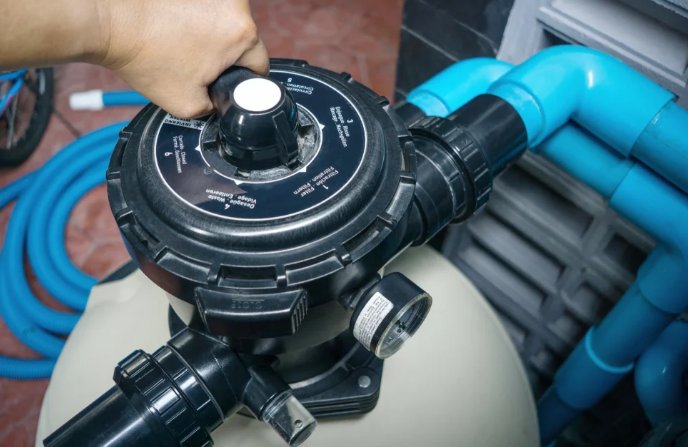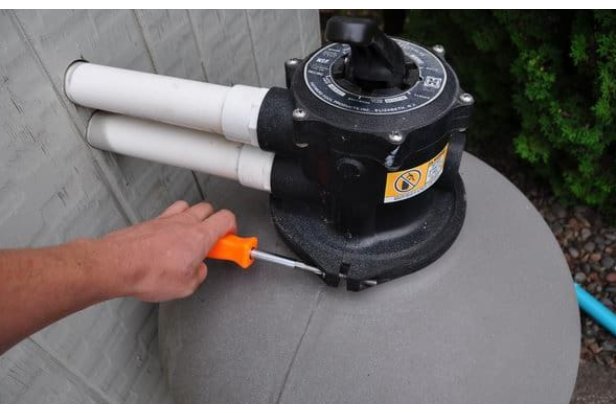Why Is My Pool Filter Blowing Out Sand – How to Fix
Maintaining clean swimming pool water depends on a functioning pool filter. You have a problem though when your filter starts spitting sand into the water.
In this article, I’ll give you advice on how to determine whether your filter needs to be changed, the causes of its sand-blowing behavior, and—most importantly—how to fix the issue.
Reasons Why Your Pool Filter is Blowing Out Sand
The sand and debris are being blown out of your pool filter for one of two reasons.
Reason 1: Shattered Laterals
A layer of sand on the bottom of your pool’s floor is a sure sign that your lateral is broken or cracked.
Around 6 to 10 concentric pipes together formed the lateral. The sand bucket’s filtered water is made to flow back into the pool with the assistance of these pipes. Sand enters the pipes when they crack, even the smallest one, and is carried back into the pool, creating murky, sandy water.
How to Fix It
The lateral in your pool filter will require complete replacement. Simply covering up the cracks is not an option and will only lead to future damage. Fortunately, replacing the lateral is a simple DIY project. Here is a step-by-step tutorial on how to remove and replace the lateral.
Supplies Needed
- Replacement lateral pipe
- Filter sand
- Teflon tape
- Unions
- Lubricant (optional)
Step 1: Turn off the pool pump
Turn off the pool pump to start the process. It should be shut off at the circuit breaker, in my opinion.
Step 2: Drain water from the pool pump and disconnect the waste hose
To let the water out of the tank, remove the cap from the pool pump. Remove the waste hose from the multiport valve after the water has finished draining.
Step 3: Remove the multiport valve
Unscrew the unions securing the Pump and Return ports in order to remove the multiport valve. To prevent them from getting lost, keep the unions in a secure location. To remove the multiport valve, all bolts and clamps must be unscrewed.
To take it out of the tank, gently twist it as you lift it. For storage, put it someplace dry.
Step 4: Tape the standpipe
Use teflon tape to seal the opening to prevent sand from leaking into the standpipe while the sand is being changed.
Step 5: Remove sand from the tank
Scoop out the sand in the tank with care to expose the laterals. This will be useful when taking the laterals out of the tank.
Step 6: Rotate and lift the laterals out of the tank
Lift the entire ensemble out of the tank slowly after gently rotating the laterals up to lie flat against the pipe.
Step 7: Replace the damaged lateral(s)
It is necessary to replace any laterals that have holes or cracks. Start by removing the screws, separating the top from the bottom section to release the laterals, and removing the broken lateral or laterals.
The new lateral should be positioned correctly on the bottom section before being placed there. Following that, atop the bottom section, place the top section. To force the two sections together, tighten all the screws.
Step 8: Clean the tank and check the laterals
Check that all laterals can be rotated to fit into the tank opening before reinstalling the lateral ensemble and make sure the tank is free of debris and old sand.
Step 9: Place the laterals into tank
The laterals and standpipe can now be inserted back into the tank after being rotated about 90 degrees into the proper position.
Step 10: Pour the sand back in the tank
Fill the tank with sand until all of the laterals are covered. To prevent lifting the laterals and standpipe, make sure to pour the sand in gently. The filter should typically be filled about three-quarters of the way. If in doubt, be sure to adhere to the manufacturer’s instructions. For the majority of tanks, sand levels will be properly marked.
Step 11: Lubricate O-ring
Lubricating the O-ring on the multiport valve is a smart move to make it last longer.
Step 12: Put the parts back together
Reassemble all of the broken pieces.
Step 13: Backwash
The last step is to quickly backwash the pool to make sure all the sand is gone and the filter is operating properly.
There shouldn’t be any sand in your pool’s water any longer.
Reason 2: Broken Seal
Multiple rubber seals and washers in the sand filter separate the filtered water from the sand-filled, unclean water. The seals may be broken or snapped if your water appears cloudy and you notice sand in the pool. The seals can corrode and break quickly because they function with chemical water.
The standpipe, the inlet, and the outlet are where the seals are located.

How to Fix It
The seals are fairly simple to repair. It will be necessary to disassemble the pool tank and replace each of the damaged seals. On how to do this, I’ve included a helpful step-by-step guide.
Similar steps are taken when replacing new laterals.
Supplies Needed
- New seals and washers
- Lubricant
- Filter sand
Step 1: Turn off the pump
Make sure the pump is shut off at the circuit.
Step 2: Drain the water
To start, you must first remove the tank’s cap and completely drain the water inside.
Step 3: Dismantle all parts and check seals
You must carefully disassemble every component of the filter, including the waste hose, pump and return ports, and multiport valve, in a manner similar to replacing laterals. Check each component for damage as you disassemble it using a seal or washer.
Step 4: Replace broken seals
It will be necessary to replace any seals that have cracks, are broken, or simply appear to be very old. The O-ring on the multiport valve is the seal that fails the most frequently. Roll off the previous seal to reveal the new one, then roll it in. To facilitate this process, use lubricant.
Step 5: Place sand back into the filter
If it’s time to replace the sand in your filter, add fresh material. Simply re-use the used sand in the filter if it is only a year or two old.
Step 6: Put the parts back together
Reassemble every component that was previously separated.
Step 7: Backwash
Finally, run a quick backwash to verify that everything is operating as it should.
Your sand filter should now be functioning properly with no leaks after replacing all of the seals.
How to Tell If Your Sand Filter Needs Replacing
Your pool water is still cloudy and sand-filled despite the fact that you replaced the broken laterals and snapped seals. You must regrettably replace your sand filter because it has reached the end of its useful life.
A noticeable decline in efficiency despite regular backwashing is another sign that your sand filter needs to be replaced. If this still doesn’t convince you to get a new filter, a bad sand filter clogged with greasy, sandy “lard” certainly will.
How a Sand Filter Works
A sand filter is essentially a sizable tank filled with coarser pool-grade sand than typical play sand. Gravity pulls the water downward as it enters the tank through an inlet at the top, clearing out impurities that become stuck in the sand. The laterals, which have tiny holes that keep sand out, are where the water enters the tank at the bottom. The filtered water then flows back into the pool.
Cracked Laterals: The function of the filter depends on the laterals, a group of six or eight plastic pipes that spread out in a concentric pattern. Sand can enter the return pipe and blow back into the pool if any of them crack. The vertical pipe that connects to the laterals and allows water to return to the pool, known as the standpipe, is also susceptible to cracking, but because it is made of thicker plastic, it does so less frequently.
Broken Seal: The standpipe’s connection to the multi-port connection on the top of the filter allows sand to enter the filtered water as well. This occurs when the O-ring or washer needs to be replaced because it is worn out.
How Much Does Pool Filter Sand Cost?
Do not be concerned that purchasing sand will be expensive. It’s fairly affordable. A 50-pound bag of premium pool sand costs between $10 and $17. This implies that the fill price for a typical 150-pound filter won’t exceed $75.
When Should You Simply Replace the Pool Filter?
Generally speaking, a filter that is spraying sand doesn’t need to be replaced. If the cost of repairing the filter is more than half that of a new filter, you might still want to do it. This won’t happen in the majority of circumstances. It might be too old to function properly going forward if you observe that your filter has several problems.
Your pool filter should likely be replaced every six to eight years, according to a good rule of thumb. It may be necessary to consider this a warning that it’s time to purchase a new filter if you’ve had your pool filter for many years. Even if you are unsure of the filter’s age, it may still be wise to replace it with a new model.
If your pool filter is still covered by warranty and is still fairly new, you might want to give the manufacturer a call. You should get your filter replaced for free if it’s possible that it’s defective.
Bottom Line
The most frequent causes of your filter blowing sand into your pool water are broken laterals and ruptured seals. Therefore, the next time it does, don’t freak out because you now know what to look for and how to fix it. It may be time to purchase a new sand filter if the suggested fixes don’t work.
Related Questions
Why is My Pool Filter Blowing Out Dirt
Your pool filter may be blowing sand out due to fractured laterals. A broken seal might be the source of a second factor. The O-ring is the seal that breaks the most frequently. After addressing the laterals and seals, a new filter may be necessary if your pool filter is still blowing out sand.
Will a Sand Filter Catch All the Algae in My Pool?
Although sand filters are very effective at removing the majority of impurities, the truth is that algae is one of their weaknesses. You can’t count on sand filters to completely remove all of the algae from your pool because of the size of some algae particles. Turn off the filter and pump and give your pool 24 hours to rest if you want to completely clear it of algae. After that, vacuum the algae off the pool’s bottom.
How Can You Tell If You Put Too Much Sand in Your Pool Filter?
There is a good chance that your pool filter won’t be able to close if you add too much sand to it. If you can put it together, you will quickly notice that the filter doesn’t quite operate correctly. It might be too noisy or it might not be able to filter everything in the pool. Occasionally, if you put too much sand inside your filter during reassembly, it could break.
How Much Sand Should a Pool Filter Have Inside of It?
It’s a common misconception that sand must be added to the brim of a pool filter. Contrary to popular belief, you only need to fill your pool filter to 2/3 capacity in order to get the most out of it. As a result, 100 gallons of sand are required for a filter with a 150-gallon capacity. Having said that, you shouldn’t be concerned about this. You can usually find out how much sand your particular filter needs by looking up the model online.
